November 2025

The global brain computer interface market size is expected to increase from USD 3.21 billion in 2025 to USD 12.87 billion by 2034, growing at a CAGR of 16.7% throughout the forecast period from 2025 to 2034, as a result of the growing prevalence of neurodegenerative disorders and increasing number of gaming industries implementing BCI technologies.
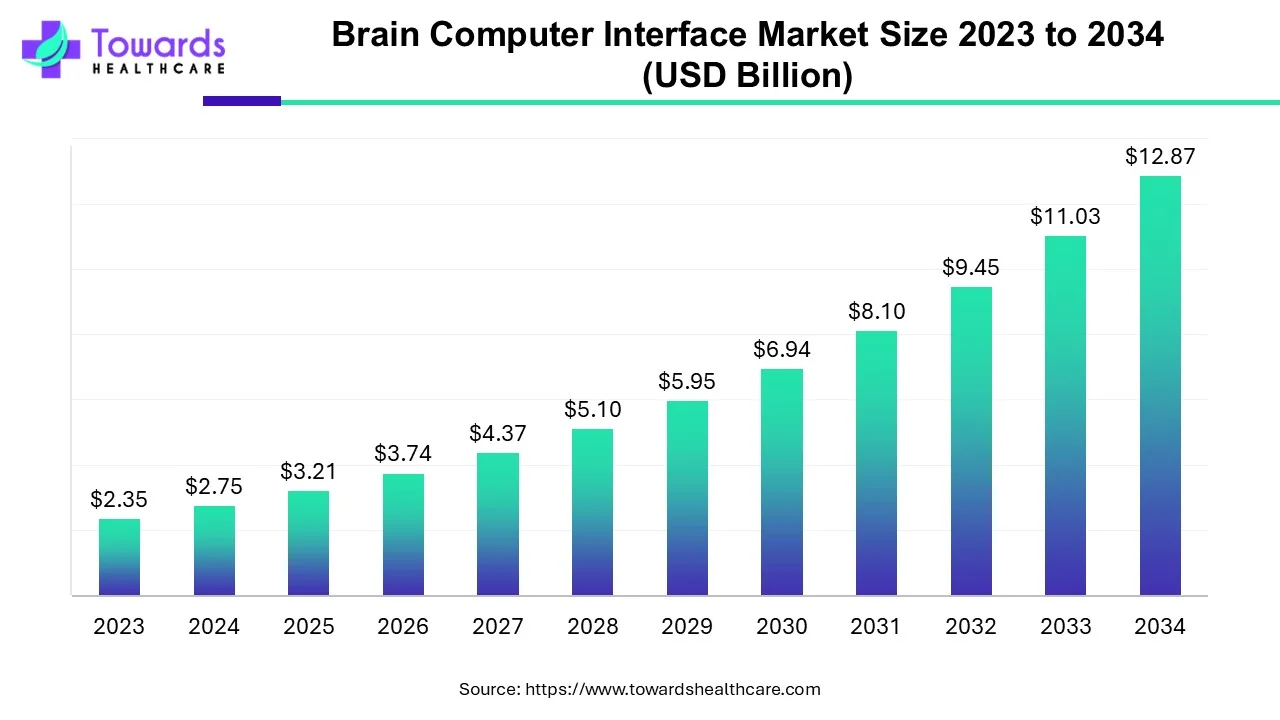
The brain-computer interface (BCI) market refers to the industry focused on developing and commercializing devices and systems that allow direct communication between the brain and an external device or computer. BCIs use various technologies to interpret and translate brain signals into actions, such as controlling a cursor on a screen or robotic arm. The market for BCI technology is growing rapidly due to its potential to revolutionize a wide range of fields, including medicine, gaming, and entertainment.
Some of the key drivers of growth in the BCI market include advancements in neuroscience and neuro-engineering, increased funding from governments and private investors, and the potential for BCI technology to improve the quality of life for individuals with disabilities or neurological disorders. However, there are also significant challenges facing the BCI market, including the complexity of the technology, ethical concerns around brain privacy and ownership, and regulatory hurdles. The brain-computer market is still in the early stages of development but is expected to see significant growth in the coming years as research and development continue and new applications for the technology are discovered.
An apparatus known as a brain-machine interface (BMI) converts neural information into commands that can operate external software or hardware, such as a machine or robotic arm. BMIs are frequently utilized by people with sensory or motor disabilities as assistive living tools. The initial goal of BCI technology development was to enable paralyzed persons to think-operate assistive equipment. However, new application cases are always being found. For instance, BCI can now be utilized as a training tool for neurofeedback to enhance cognitive function. BCI has potential uses in various industries and provides greater flexibility either by enhancing or replacing human peripheral functioning capacity.
Artificial intelligence (AI) is an indispensable part of the brain-computer interface, resulting in improved performance. AI enables direct stimulation of brain tissue, enabling bidirectional brain-machine interaction. AI-enabled BCI fundamentally improves treatment options for severe brain disorders. It helps healthcare professionals to better understand the workings of the brain and create more accurate simulations. AI and machine learning (ML) algorithms detect changes in brain signals and convert them into appropriate control signals. Thus, AI and ML significantly improve the overall functioning of BCI. The advent of AI-based sensors can record neural signals, interpret movement intentions, and a complete cursor that interacts with the external environment.
Brain-computer interfaces (BCIs) are a rapidly developing field of technology that allows for direct communication between the human brain and computers or other electronic devices. BCIs have a wide range of potential applications, including in healthcare, communication & control, smart home control, and entertainment & gaming. The healthcare industry is the currently leading and the largest contributor with the highest 58.63% market share in the BCI market in 2022. While smart home control applications are projected to grow at the fastest CAGR of 19.4% over the forecast period.
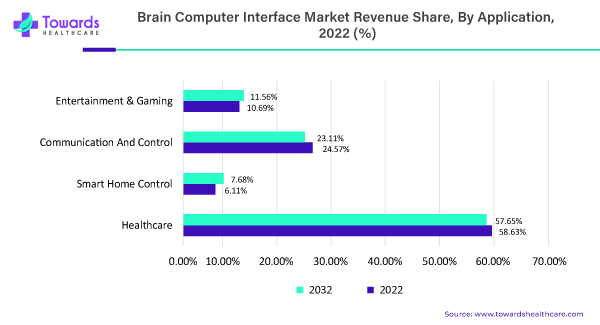
The promising use of BCIs is in the treatment of neurological disorders such as Parkinson's disease, epilepsy, and stroke. BCIs can be used to help patients regain control of their movements, speech, and other bodily functions that may be impaired by these conditions. Another potential application of BCIs is in the field of prosthetics. BCIs can be used to control prosthetic limbs and allow users to perform complex tasks with greater ease and precision than traditional prosthetics.
CIs also have potential in the field of mental health. For example, they could be used to monitor brain activity in patients with depression or anxiety and provide feedback or stimulation to help regulate their moods and emotions.
According to estimates, 250,000 to 500,000 persons worldwide experience spinal cord injuries (SCI) each year. These injuries are linked to reduced rates of economic involvement and place a significant cost on society. Similar to this, over 15 million individuals worldwide experience a stroke each year; of these, nearly 5 million pass away, and an additional 5 million become permanently crippled, burdening their families and communities. A serious neurodegenerative condition that affects nerve cells in the brain and spinal cord is called amyotrophic lateral sclerosis (ALS). One in 50,000 persons globally is thought to get ALS on average each year, which translates to 5,760 to 6,400 new cases of the disease.
Neurodegenerative disorders, such as Alzheimer's disease, Parkinson's disease, and amyotrophic lateral sclerosis (ALS), are a growing health concern worldwide. These disorders are characterized by the progressive degeneration and death of nerve cells in the brain or spinal cord, leading to a range of debilitating symptoms, including cognitive impairment, motor dysfunction, and loss of independence.
Brain-computer interfaces (BCIs) are emerging as a promising tool to help address the rising burden of neurodegenerative disorders. BCIs allow direct communication between the brain and a computer or other external device, bypassing the need for traditional forms of input, such as a keyboard or mouse. This technology has the potential to enable people with neurodegenerative disorders to regain some level of independence and improve their quality of life.
For example, BCIs can be used to control prosthetic limbs or other assistive devices, allowing people with motor dysfunction to perform everyday tasks that were previously impossible. BCIs can also be used to monitor brain activity and detect early signs of cognitive decline or other neurological changes, allowing for earlier diagnosis and intervention. While the field of BCI research is still in its early stages, there has been significant progress in recent years. A number of companies and research institutions are actively developing and testing new BCI technologies for use in healthcare, with promising results.
However, there are still several challenges that need to be addressed before BCIs can become widely available for people with neurodegenerative disorders. These include improving the accuracy and reliability of BCI systems, addressing issues of user comfort and convenience, and ensuring that these technologies are affordable and accessible to all who need them.
Despite these challenges, the potential benefits of BCIs in addressing the rising burden of neurodegenerative disorders are significant, and the field is likely to continue to grow and evolve in the coming year.
Developers of smart home appliances are concentrating on product development and innovation, which is expected to drive the market for brain-computer interfaces throughout the forecast period. Due to their great stability and precision, BCI devices are suitable for controlling smart home applications. Home management systems use P300-based technology to assist with tasks including closing and opening doors, turning lights on and off, controlling TV and audio systems, and activating security cameras. The use of BCI in smart homes offers a convenient way to control devices without the need for physical touch or traditional remote controls, making them more accessible and user-friendly for individuals with disabilities or mobility impairments.
The rise in smart home control technology has been driven by various factors, including increasing investments in IoT infrastructure, targeted R&D efforts in smart technology enablement, and the rising use of smart home control devices. Brain-computer interface (BCI) technology has also played a role in driving the growth of the smart home sector, as it offers a more seamless and efficient way to control and monitor household equipment and appliances connected via BCI.
As the use of brain-computer interface technology grows, so does the importance of data privacy and the risk of cyberattacks. Brain-computer interface devices collect sensitive information about a person's brain activity, and if this information were to fall into the wrong hands, it could have serious consequences for the individual.
Additionally, cyberattacks on brain-computer interface devices could potentially allow malicious actors to manipulate the device and control the individual's actions. This could be particularly dangerous in medical applications of the technology, where a compromised device could have serious health consequences for the patient.
The rise in cybersecurity threats and data privacy concerns have been a major challenge for industries across the board, including those utilizing brain-computer interface (BCI) technology. While BCI offers immense potential for innovation and growth in fields such as healthcare and smart home control, the sensitive nature of the data collected and processed by BCI devices requires robust cybersecurity measures and stringent data privacy protocols.
To overcome these restraints, industry leaders are investing in cutting-edge cybersecurity technologies and implementing stringent data privacy policies. This includes utilizing multi-factor authentication methods, encryption technologies, and continuous monitoring systems to safeguard BCI devices and the data they collect. Additionally, collaboration between industry leaders, policymakers, and cybersecurity experts is crucial in developing comprehensive regulatory frameworks that ensure data privacy and cybersecurity standards are met.
Addressing cybersecurity and data privacy concerns is not only essential for protecting users' sensitive information but also for fostering trust in BCI technology and driving growth and innovation in the industry. As industries continue to adopt BCI technology and expand their applications, robust cybersecurity and data privacy measures will become increasingly critical for ensuring the long-term success and sustainability of these innovations.
Governments around the world have recognized the potential of brain-computer interfaces (BCIs) in improving healthcare services and have made significant investments in advancing this technology. These investments include funding research and development, providing grants, and implementing regulations that enable people to benefit from new medical technologies. The increased government support has led to the growth and expansion of research efforts to increase the use of BCIs in treating neurodevelopmental disorders and other medical conditions.
Governments play a critical role in driving the growth of the brain-computer interface (BCI) market by investing in research and development, providing funding and grants, and implementing policies and regulations that support the advancement of this technology. These initiatives have resulted in an increased focus on using BCIs to improve healthcare services, including treating neurodevelopmental disorders and other medical conditions.
Furthermore, policymakers play a crucial role in promoting innovative treatments by encouraging brain research and the development of novel medicines. The development of regulations and policies that support the advancement of BCI technology has also helped to fuel the market for BCIs. For instance, reimbursement policies implemented by governments have enabled regular people to benefit from newly discovered medical technologies and improved infrastructure.
Moreover, governments recognize that BCIs have the potential to transform healthcare, leading to better patient outcomes, reduced healthcare costs, and improved quality of life. By investing in research and development, governments are supporting the growth of BCI technology and encouraging the development of new applications and treatments.
The US Defense Advanced Research Projects Agency (DARPA) has awarded funds to six organizations (including $9.8 million to Rice University academics) for the Next-Generation Nonsurgical Neurotechnology (N3) initiative. The non-invasive or minimally invasive neural interfaces connecting combat warriors' brains to computers are the goal of the brain-computer interface investment project, which will enable quick, efficient, and natural interaction with military hardware.
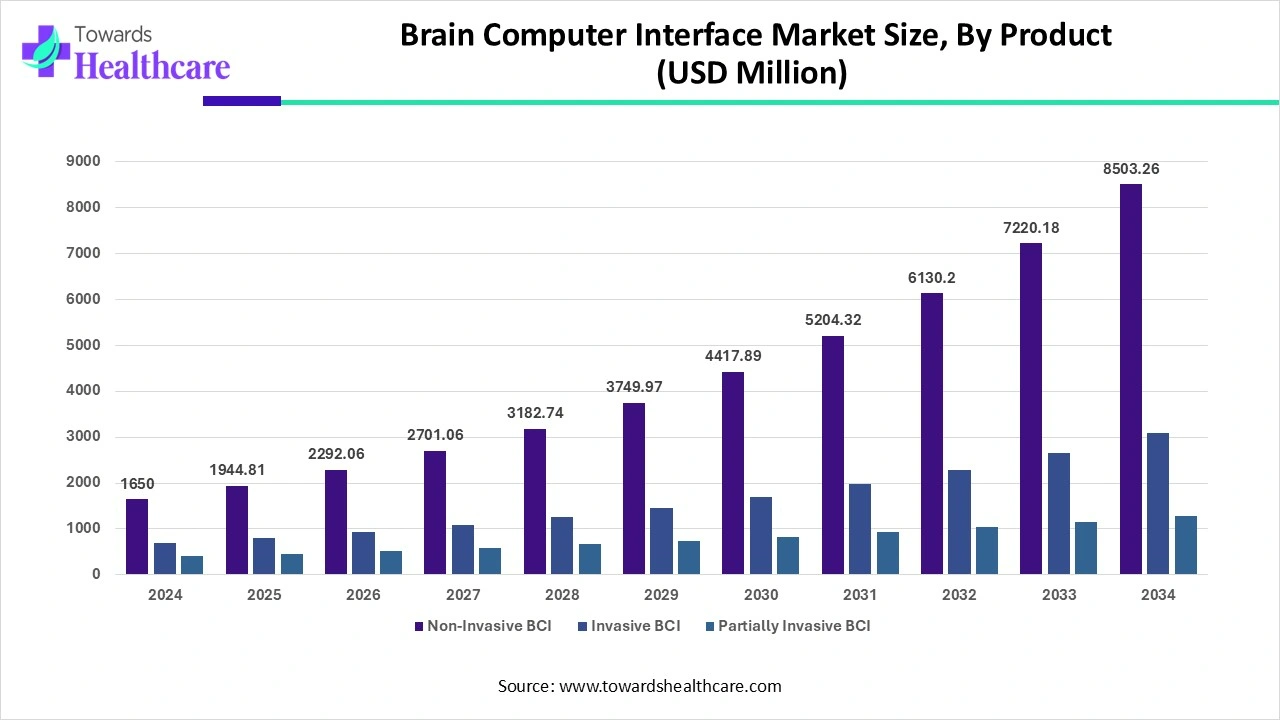
By product, the non-invasive BCI segment held a dominant presence in the market in 2024. Non-invasive BCI measures brain activity from external devices without surgery. The growing demand for non-invasive surgeries and treatment, as well as technological advancements, augment the segment’s growth. Numerous non-invasive BCIs use EEG signals, i.e., the electrical brain activity recorded from electrodes placed on the scalp. These also enable the recording of neural activity other than electrical activity in the brain. Other methods include using MEG or MRI. Thus, speech, movement, or attention can be controlled through an external device without moving a muscle.
By product, the invasive BCI segment is predicted to witness significant growth in the market over the forecast period. Invasive BCI refers to a device or microelectrode that is implanted into a human brain. It enables direct communication between the brain and the computer. The demand for invasive BCI increases as it can measure the activity of a single neuron, which is not possible through non-invasive BCI. Additionally, it can obtain neural signals with a much higher spatial and temporal resolution.
By end-use, the medical segment held the largest share of the brain computer interface market in 2024. BCIs have widespread use in the medical field, from wheelchairs to robotic arms. BCIs assist individuals and improve their quality, especially for patients affected by diseases, disabilities, or paralysis. The burgeoning healthcare sector and favorable government policies propel the segment’s growth. The rapidly expanding neuroscience field and clinical rehabilitation technology increase the demand for BCIs. The increasing investments from various government and private organizations promote the use of BCIs.
By end-use, the military segment is anticipated to grow significantly in the market over the coming years. BCI in military applications could allow soldiers to communicate directly with each other through machines. It is estimated that in 2040, BCI technology will have significant military benefits such as heightened situational awareness, enhanced autonomous system management, and human cognitive enhancement beyond natural abilities. All these benefits will present future opportunities for the market.
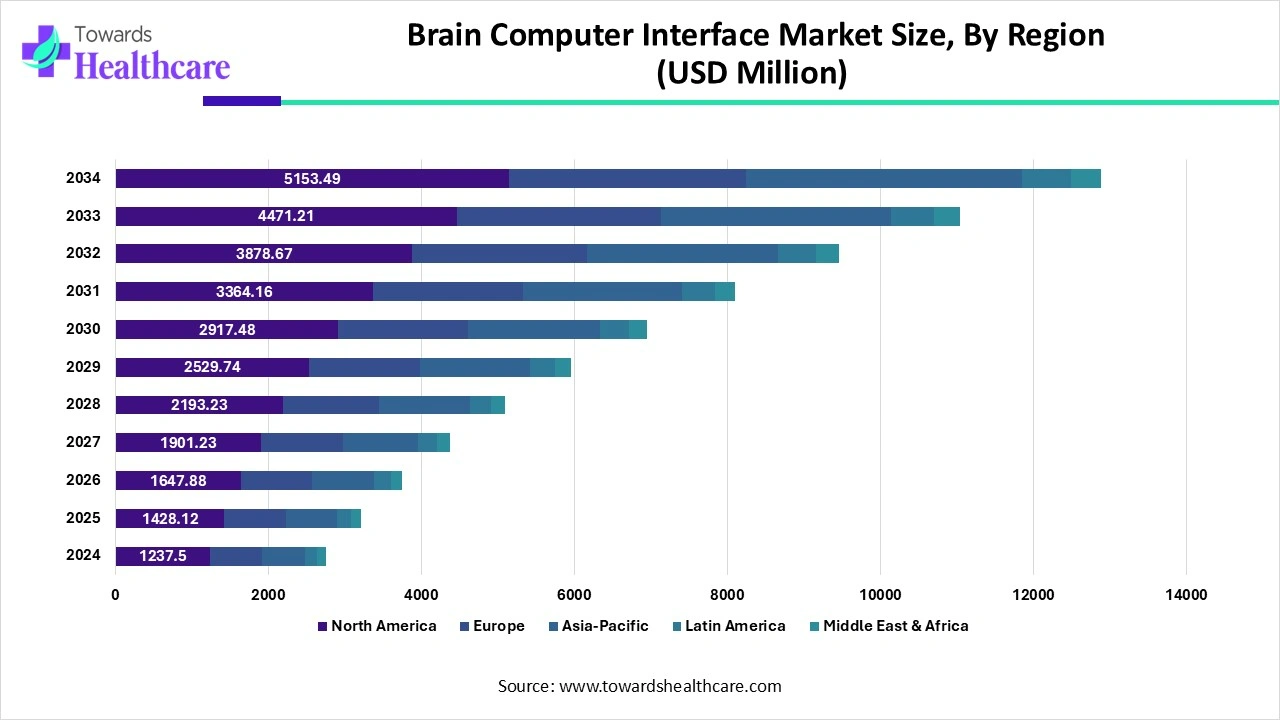
North America is a leading region in the brain-computer interface market due to the presence of key players. The increasing prevalence of neurological disorders and the high adoption rate of advanced technology in the region have also contributed to the growth of the market. North America held around 39.77 % market share in 2022, while Asia Pacific is projected to register the fastest growth with a CAGR of 17.3% (2023-2030).
In addition, the region has witnessed significant investments from government and private organizations to promote the development of brain-computer interface technology. The region has a well-established healthcare infrastructure and a high level of healthcare spending, which has also contributed to the growth of the brain-computer interface market. The increasing demand for non-invasive and minimally invasive brain-computer interfaces, especially for the treatment of neurological disorders, is expected to drive market growth in the region in the coming years.
Furthermore, the rising popularity and demand for realistic gaming is likely to thrive with the advancement of innovative technology like enhanced brain-computer interfaces, which further accelerates the adoption of BCI technologies in the U.S., Canada, and other North American countries. Moreover, the rising number of BCI startup firms across the U.S. is bolstering the growth of the brain-computer interface market in the North American region brain co. Some of the startups operating in the field of BCI across the U.S. are Ceribell, Neuralink, Paradromics, Feelmore Labs, Cognixion, Neurable, and many others. The increasing number of product launches by such emerging startup companies related to the brain computer interface is substantially boosting the market growth in the U.S.
U.S. Market Trends
The U.S. is home to 115 BCI startups, of which 74 are funded. Blackrock, a U.S. neurotechnology giant, raised $200 million in crypto cash in April 2024 for developing BCI. The U.S. Defense Advanced Research Projects Agency (DARPA) invests millions in BCI projects annually, driving the BCI research agenda.
Canada Market Trends
The rapidly expanding healthcare sector and favorable clinical trial infrastructure encourage U.S. startups to set up their facilities in Canada. Neuralink announced plans to begin clinical trials in Canada on patients with motor disabilities and communication issues. The University of Ottawa also hosted an event to explore the ethical and legal issues of BCIs in Canada.
On the other hand, rising healthcare expenditure, the development of advanced infrastructure, and increasing patient awareness about advanced healthcare solutions are some of the major reasons for the growth of brain computer interface market in the Asia Pacific region. The rising incidences and prevalence of neurological disorders in people living in Asia-Pacific countries potentiate the demand for BCIs. The growing research and development activities and favorable government support promote the use of BCIs in Asia-Pacific.
China Market Trends
China aims to become a global leader in the BCI sector. The Chinese government launched a roadmap to achieve breakthroughs in BCI by 2027 and establish an internationally competitive industry by 2030. China’s Ministry of Science and Technology released the “Guidelines for Research Ethics in Brain-Computer Interface” to clarify the ethical norms for BCI research and applications and to promote its sustainable development.
India Market Trends
The increasing investments and the growing number of start-ups also contribute to market growth. The total venture capital investments in BCI start-ups in India amounted to $518 million in 2023. In October 2024, researchers from the Institute of Nano Science and Technology (INST) developed an artificial synaptic device to emulate the behavior of biological synapses.
Europe is expected to experience significant growth in the brain computer interface market during the forecast period. This is due to rising incidences of neurodegenerative diseases as well as advancing healthcare sectors. The European government forms regulatory frameworks to support BCI research activities and clinical trials. Government and private organizations provide funding for the development of innovative BCIs. The increasing number of BCI startups also contributes to market growth. The Graphene Flagship project by the European Commission funded INBRAIN Neuroelectronics human trial of its cortical interface in a patient undergoing brain tumor resection.
Germany Market Trends
The industries in Germany are well developed, which in turn increases the development of the brain computer interface due to rising diseases. This is further supported by the government and the regulatory bodies.
UK Market Trends
The industries in the UK are collaborating to increase the production of brain computer interface systems due to the increasing demand to treat neurodegenerative diseases. These developments are in compliance with regulations imposed, which enhances patient satisfaction.
Dr. Christoph Guger, Founder and CEO of g.tec Medical Engineering commented that the company offers its solutions globally and has sales offices in the U.S., Canada, Colombia, Spain, Hong Kong, Japan, and Australia. The company’s innovative products address diverse neuroscience applications, including neurorehabilitation, brain mapping, and consciousness disorders. He also said that the company is now launching a franchise model for recoveriX, enabling entrepreneurs to establish their neurorehabilitation businesses.
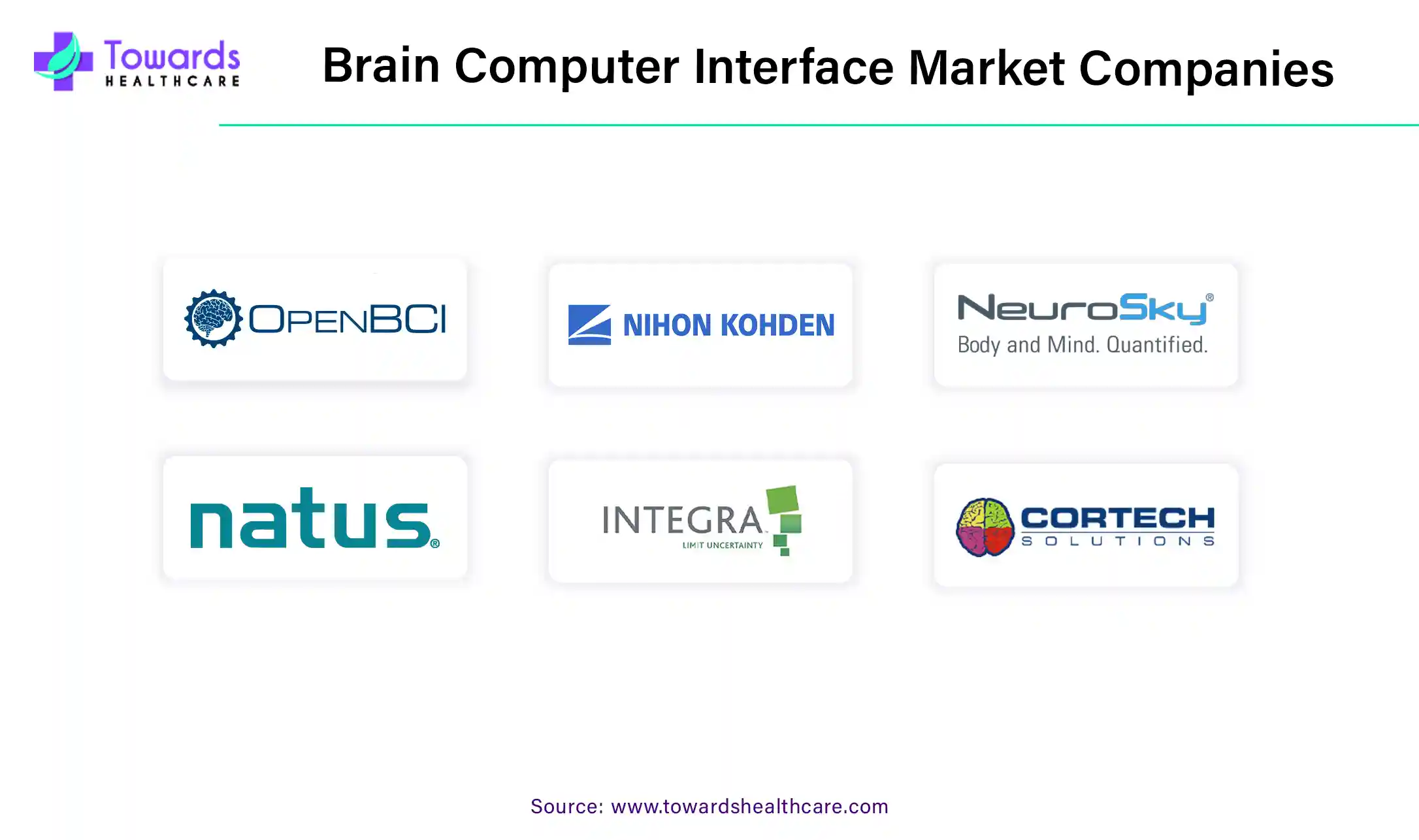
Read further to see how top players are redefining the Brain Computer Interface Market at: https://www.towardshealthcare.com/companies/brain-computer-interface-companies
By Product
By Application
By End User
By Region
November 2025
November 2025
November 2025
November 2025